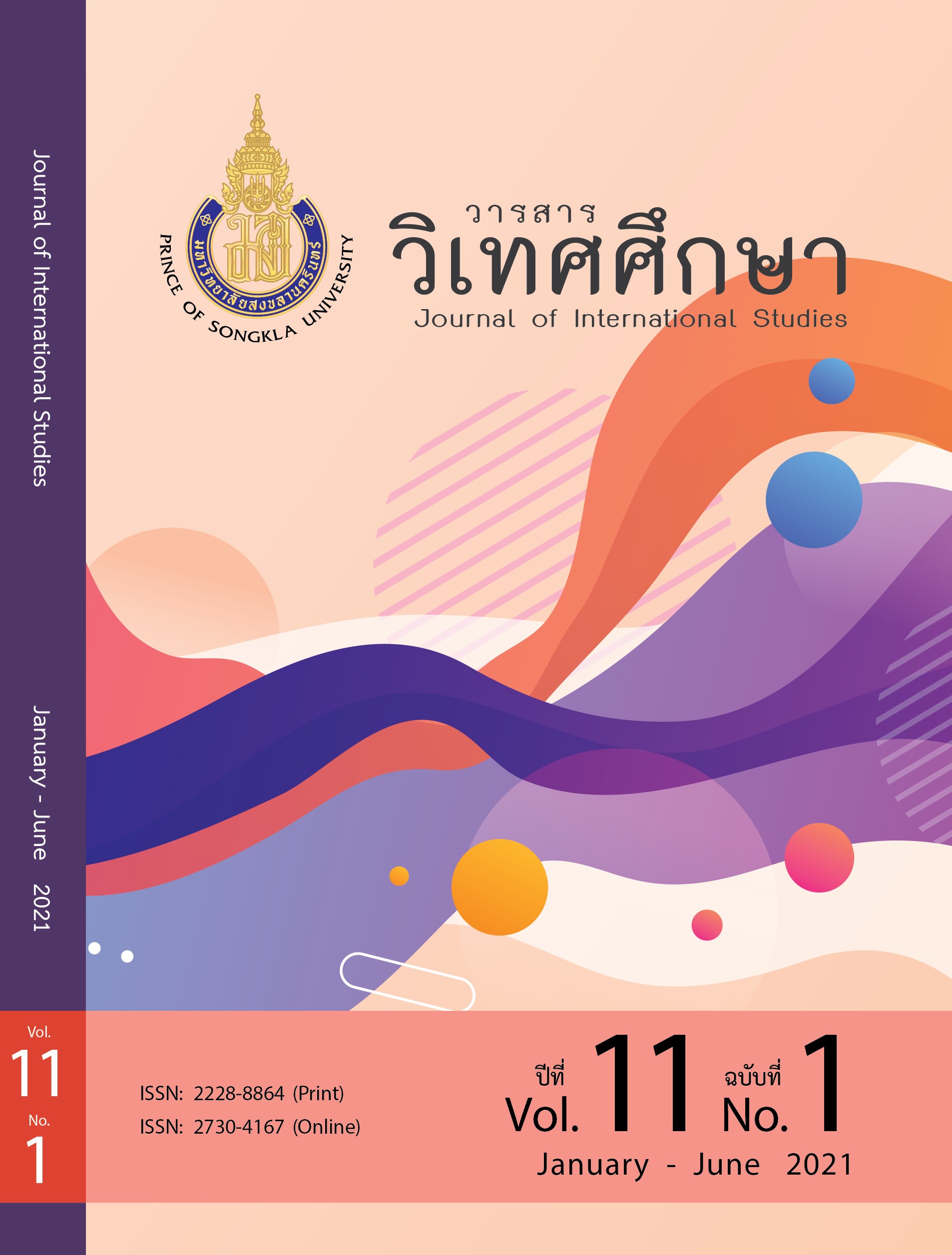Making Jak sugar the traditional way in Pak Phanang district, Nakhon Si Thammarat province, Thailand: A Case Study
Main Article Content
Abstract
This paper presents fieldwork research into the traditional community method of making Jak sugar (Nipa palm sugar) and other traditional products made from Jak trees (Nypa fruticans, also known as Nipa palm trees). The study was conducted in a community at Pak Phanang district, Nakhon Si Thammarat province, in the south of Thailand. The study employed a qualitative approach using in-depth interviews and observation. We found that the process of making Jak sugar is quite complicated. Firstly, the tools are prepared. Secondly, the Jak tree is selected. Thirdly, its stalks are cut, and the nectar is obtained from the Jak tree. Finally, the Jak sugar is refined from the nectar. Each step uses traditional wisdom that has been passed from generation to generation. In addition, community members make other products from various parts of Jak trees. For example, Jak leaves are used to make hats, a roofing material for houses, cigarette papers, children’s toys, water scoops, and pastry wraps. The Jak leaf sheaths are used for fuel, and Jak stalks are used to make brooms and baskets. The Jak fruits are used to make desserts. These products of the Jak tree are all strongly reflected in, and related to, the way of life of the community.
Article Details
Statements and opinions expressed in articles herein are those of the authors and do not necessarily reflect the position of the editors or publisher.
Article, information, text, image, etc. which are published in Journal of International Studies, belong to Journal of International Studies. If anybody or any organization would like to use part or whole of them, they must receive written permission from Journal of International Studies before usage.
References
กมลวรรณ พันเพชร, และคณะ. (ม.ป.ท.). น้ำตาลจากบ้านหัวป่าขลู: ภูมิปัญญาในการทำน้ำตาล จากกรณีศึกษา ชุมชนบ้านหัวป่าขลู หมู่ที่ 2 ตำบลขนาบนาก อำเภอปากพนัง จังหวัดนครศรีธรรมราช. ค้นเมื่อ 10 เมษายน 2563, จาก http://human.nstru.ac.th/student_research/pload_images/20170517195016sugar%20production.pdf
จันทิรา รัตนรัตน์. (2561). ศักยภาพของพื้นที่สําหรับการปลูกข้าวและการปรับตัวของชาวนาจากปัญหาอุทกภัย ตําบลขนาบนาก อําเภอปากพนัง จังหวัดนครศรีธรรมราช. วารสารวิทยาศาสตร์และเทคโนโลยี, 26(4), 551-562.
ฉัตรทิพย์ นาภสุภา. (2540). ประวัติศาสตร์ วัฒนธรรมชุมชนและชนชาติไท. กรุงเทพฯ: จุฬาลงกรณ์มหาวิทยาลัย.
นพรัตน์ บำรุงรักษ์. (2540). การศึกษาด้านนิเวศวิทยา ประโยชน์ใช้สอย และการขยายพันธุ์ต้นจากในพื้นที่ลุ่มน้ำปากพนัง จังหวัดนครศรีธรรมราช. รายงานการวิจัยสำนักงานคณะกรรมการวิจัยแห่งชาติ.
นัฐพร แก้วตาทิพย์. (2557). การผลิตและการตลาดนํ้าตาลจากของเกษตรกรในอําเภอปากพนัง จังหวัดนครศรีธรรมราช. การประชุมเสนอผลงานวิจัยระดับบัณฑิตศึกษา. มหาวิทยาลัยสุโขทัยธรรมาธิราช ครั้งที่ 4, วันที่ 26-27 พฤศจิกายน 2557.
ประเวศ วะสี. (2541). ยุทธศาสตร์ชาติ: เพื่อความเข้มแข็งทางเศรษฐกิจสังคมและศีลธรรม. กรุงเทพฯ: สำนักพิมพ์หมอชาวบ้าน.
พวงเพชร สุรัตนกวีกุล. (2544). มนุษย์กับสังคม (พิมพ์ครั้งที่ 3). กรุงเทพฯ: มหาวิทยาลัยเกษตรศาสตร์.
พัทยา สายหู. (2534). การพัฒนาวัฒนธรรมบนพื้นฐานภูมิปัญญาชาวบ้านและศักยภาพของชุมชนในการสัมมนาทางวิชาการเรื่อง ภูมิปัญญาพื้นบ้าน. กรุงเทพมหานคร: สำนักงานคณะกรรมการวัฒนธรรมแหงชาติ.
มณีมัย ทองอยู่. (2546). การเปลี่ยนแปลงของเศรษฐกิจชาวนาอีสาน: กรณีชาวนาลุ่มน้ำพอง. กรุงเทพฯ: สร้างสรรค์.
เมดไทย. (2556). จาก. ค้นเมื่อ 10 กันยายน 2561, จาก https://www. Medthai.com
สนธยา พลศรี. (2545). ทฤษฎีและหลักการพัฒนาชุมชน. กรุงเทพฯ: โอเดียนสโตร์.
สุพัตรา สุภาพ. (2541). ปัญหาสังคม (พิมพ์ครั้งที่ 15). กรุงเทพฯ: ไทยวัฒนาพานิช.
ส่วนส่งเสริมและพัฒนาทรัพยากรป่าชายเลน. (2557). การจัดการป่าจากในลุ่มน้ำปากพนัง. กรุงเทพฯ: ส่วนส่งเสริมและพัฒนาทรัพยากรป่าชายเลน สำนักอนุรักษ์ทรัพยากรป่าชายเลน กรมทรัพยากรทางทะเลและชายฝั่ง.
เสรี พงศ์พิศ. (2549). แนวทางการนำภูมิปัญญาท้องถิ่นเข้าสู่ระบบการศึกษา. กรุงเทพฯ: สำนักงานคณะกรรมการวัฒนธรรมแห่งชาติ.
เอกวิทย์ ณ ถลาง. (2552). ภูมิปัญญาชาวบ้าน 4 ภูมิภาค: วิถีชีวิตและกระบวนการเรียนรู้ของชาวบ้านไทย. นนทบุรี: มหาวิทยาลัยสุโขทัยธรรมาธิราช.


